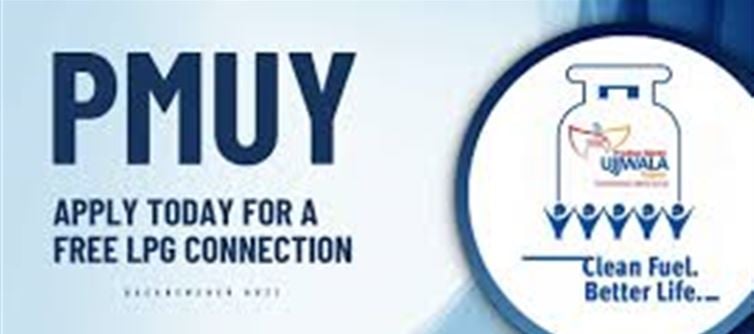
The Pradhan Mantri Ujjwala Yojana (PMUY), launched in May 2016, has been one of India’s most impactful social and environmental welfare programs. By providing free LPG (liquefied petroleum gas) connections to women from below-poverty-line (BPL) households, the scheme has not only improved public health and household safety but also accelerated India’s transition toward cleaner, greener energy.
🌿 The Vision Behind Ujjwala Yojana
Before Ujjwala, a large number of rural families relied on firewood, dung cakes, coal, and kerosene for cooking. This led to:
· Indoor air pollution, causing respiratory diseases and premature deaths.
· Deforestation due to extensive firewood collection.
· Health hazards for women and children, who spent long hours near smoky stoves.
· Time poverty, as women spent several hours daily collecting firewood instead of pursuing education or income-generating work.
Recognizing these issues, the government launched PMUY with the vision of ensuring universal access to clean cooking fuel, improving women’s health, and advancing energy equity.
🏠 Key Features of the Scheme
Parameter
Details
Launched By
Government of india (Ministry of Petroleum and Natural Gas)
Launch Date
1 May 2016
Target Group
Women belonging to BPL households
Benefit
Free LPG connection with a stove and first cylinder
Implementing Agency
Public Sector oil Marketing Companies (OMCs) — IndianOil, Bharat Petroleum, Hindustan Petroleum
Financial Support
₹1,600 per connection (borne by the central government)
Phases
Phase 1 (2016–2019), Phase 2 (Ujjwala 2.0, launched in 2021)
📈 Impact and Achievements
1. Massive Expansion of LPG Access
· Before PMUY, LPG penetration in india was only about 55%.
· As of 2025, over 9.6 crore LPG connections have been released under the scheme.
· Rural and remote villages, especially in states like Uttar Pradesh, Bihar, Madhya Pradesh, Odisha, and Rajasthan, have witnessed a dramatic shift toward cleaner fuels.
2. Improved health and Quality of Life
· Studies by the World health Organization (WHO) show that exposure to household air pollution is a leading cause of respiratory and cardiac diseases.
· With LPG, families now cook without inhaling harmful smoke. This has significantly reduced cases of chronic bronchitis, eye irritation, and lung infections among women and children.
3. Empowerment of Women
· The scheme directly benefits women, giving them control over household energy choices.
· Reduced time spent on collecting fuel allows them to focus on education, livelihood, and family welfare.
· It promotes gender equality by giving women greater autonomy in managing their households.
4. Environmental Benefits
· Decreased reliance on firewood helps curb deforestation and carbon emissions.
· India’s shift to LPG contributes to its sustainable development goals (SDGs) — especially SDG 7 (Affordable and Clean Energy) and SDG 13 (Climate Action).
5. Economic and Industrial Boost
· The surge in LPG demand has expanded the distribution infrastructure: more bottling plants, dealers, and last-mile delivery agents.
· This has created employment opportunities, especially in rural logistics and small-scale entrepreneurship.
💡 Ujjwala 2.0 — The Next Phase
In August 2021, the government launched Ujjwala 2.0, an upgraded version of the scheme.
Key highlights include:
· Additional one crore free LPG connections to low-income families not covered earlier.
· Simplified documentation — migrants can apply with self-declaration only.
· Free first refill and hotplate to encourage consistent usage.
· Focus on refill affordability through direct benefit transfers and subsidies.
The goal is to make LPG a sustainable habit, not just a one-time benefit.
⚙️ Challenges and government Efforts
While the Ujjwala Yojana is a massive success, it faces challenges such as:
· Refill affordability: Many poor households find cylinder refills expensive.
· Behavioral shift: Some users still use firewood alongside LPG due to cultural habits.
To address these, the government has:
· Introduced subsidy restoration (under PMUY 2.0) for targeted beneficiaries.
· Expanded smaller 5 kg cylinder options for cost flexibility.
· Run awareness campaigns on the health and environmental benefits of LPG use.
🌍 How the Ujjwala Yojana Benefits the Nation
1. Public Health: Lower incidence of respiratory illnesses and indoor pollution-related deaths.
2. Environment: Reduced carbon footprint and pressure on forests.
3. Social Welfare: Improved dignity, safety, and comfort for women.
4. Economic Growth: Boost in rural employment and fuel distribution networks.
5. Global Leadership: Strengthens India’s image as a nation committed to clean energy and climate action.
📊 Real-World Impact — In Numbers
Metric
2016
2025 (approx.)
LPG Connections
14 crore
33 crore +
Rural LPG Coverage
~55 %
~99 %
Women Beneficiaries
—
Over 9.6 crore
Smoke-related Illness Reduction
—
~30–40 % decline in rural households
💬 Conclusion
The Pradhan Mantri Ujjwala Yojana is more than just an LPG distribution program — it’s a social, economic, and environmental revolution.
By empowering women, improving public health, and promoting sustainable energy use, it has become a cornerstone of India’s clean-energy journey.
As the country moves toward a greener future, Ujjwala continues to light up millions of homes — not just with gas flames, but with hope, dignity, and cleaner air.
Disclaimer:
The views and opinions expressed in this article are those of the author and do not necessarily reflect the official policy or position of any agency, organization, employer, or company. All information provided is for general informational purposes only. While every effort has been made to ensure accuracy, we make no representations or warranties of any kind, express or implied, about the completeness, reliability, or suitability of the information contained herein. Readers are advised to verify facts and seek professional advice where necessary. Any reliance placed on such information is strictly at the reader’s own risk.




 click and follow Indiaherald WhatsApp channel
click and follow Indiaherald WhatsApp channel